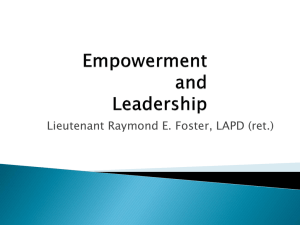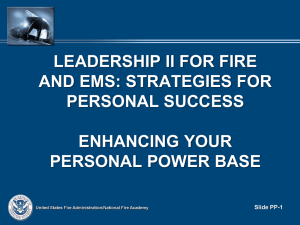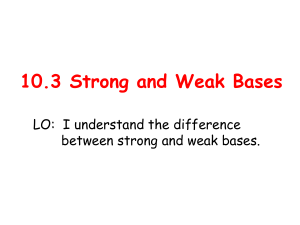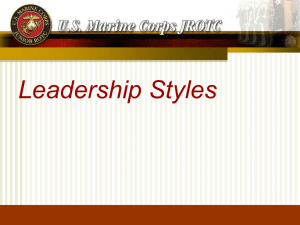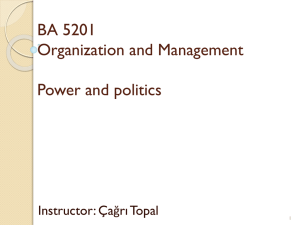a structural equations model of
advertisement
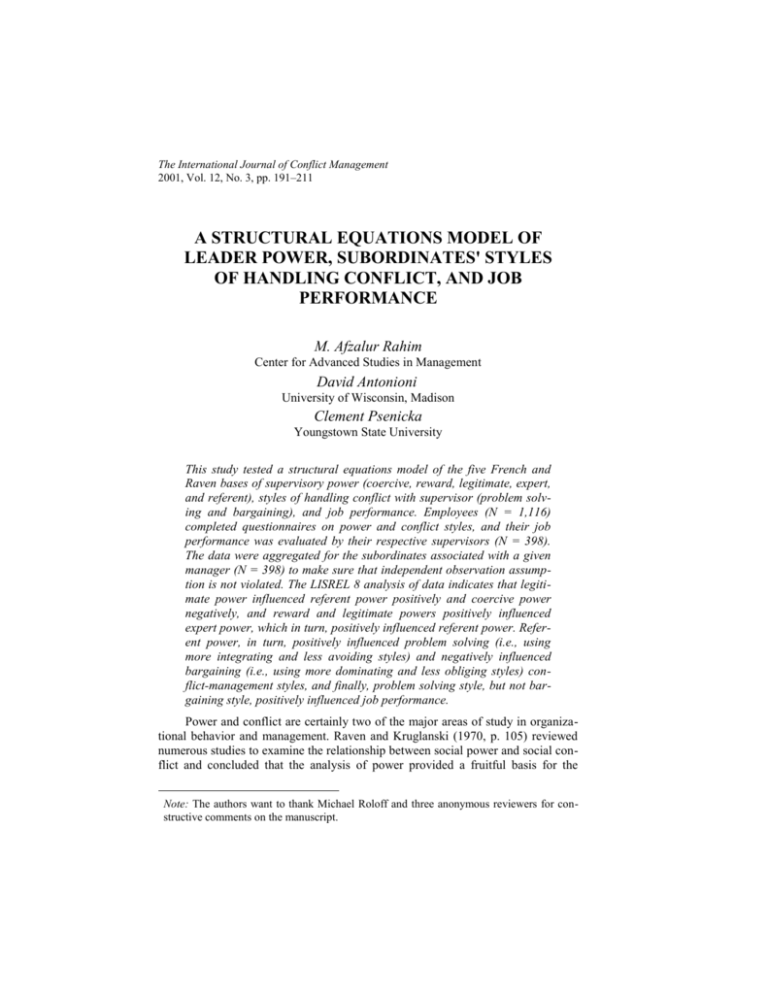
The International Journal of Conflict Management 2001, Vol. 12, No. 3, pp. 191–211 A STRUCTURAL EQUATIONS MODEL OF LEADER POWER, SUBORDINATES' STYLES OF HANDLING CONFLICT, AND JOB PERFORMANCE M. Afzalur Rahim Center for Advanced Studies in Management David Antonioni University of Wisconsin, Madison Clement Psenicka Youngstown State University This study tested a structural equations model of the five French and Raven bases of supervisory power (coercive, reward, legitimate, expert, and referent), styles of handling conflict with supervisor (problem solving and bargaining), and job performance. Employees (N = 1,116) completed questionnaires on power and conflict styles, and their job performance was evaluated by their respective supervisors (N = 398). The data were aggregated for the subordinates associated with a given manager (N = 398) to make sure that independent observation assumption is not violated. The LISREL 8 analysis of data indicates that legitimate power influenced referent power positively and coercive power negatively, and reward and legitimate powers positively influenced expert power, which in turn, positively influenced referent power. Referent power, in turn, positively influenced problem solving (i.e., using more integrating and less avoiding styles) and negatively influenced bargaining (i.e., using more dominating and less obliging styles) conflict-management styles, and finally, problem solving style, but not bargaining style, positively influenced job performance. Power and conflict are certainly two of the major areas of study in organizational behavior and management. Raven and Kruglanski (1970, p. 105) reviewed numerous studies to examine the relationship between social power and social conflict and concluded that the analysis of power provided a fruitful basis for the Note: The authors want to thank Michael Roloff and three anonymous reviewers for constructive comments on the manuscript. 192 POWER, CONFLICT, AND PERFORMANCE understanding of interpersonal conflict. Twomey (1978), over two decades ago, indicated the need for investigating how managers' power bases affect their subordinates' conflict management so that the managers can change or maintain their power bases to achieve optimum results. Unfortunately, little has been done to investigate the relationship between the two constructs and their effects on criterion variables, such as job performance. The published literature on leader power and conflict, while extensive, suffers from four deficiencies: First, the literature has devoted inadequate attention to the interrelationships among power bases. Despite Raven's (1992) call for studying how certain power bases influence the existence and use of the remaining power bases, there has been little systematic attempt to investigate this process. Second, little or no attention has been devoted to investigate whether power bases have direct, as well as mediated effects through conflict-management styles on other variables such as job performance. Third, the measures used in the early research on power bases had weak psychometric properties, and data were collected mainly from the same subjects. Fourth, the most popular method of data analysis used in the published studies was correlations between variables. This type of analysis is particularly unsuitable because there are significant intercorrelations among power bases. The present study is an attempt to bridge this gap. Specifically, it was designed to develop and test a structural equations model of how subordinates’ perception of supervisory power bases are related to each other and subordinates' own styles of handling conflict, which in turn, is related to supervisors’ evaluation of job performance. This is a more functional approach for providing alternative explanations of the relationships among correlated variables. The relationships among position (coercive, reward, and legitimate) and personal (expert and referent) power bases, problem solving and bargaining styles of handling conflict with a supervisor, and job performance are shown in Figure 1. Bases of Supervisory Power Power is defined as "the ability of one party to change or control the behavior, attitudes, opinions, objectives, needs, and values of another party" (Rahim, 1989, p. 545). This definition implies that research on power is limited to the influence of one individual (leader) over another individual (follower). Several classifications of leader or supervisory power have been set forth (Kipnis, Schmidt, & Wilkinson, 1980; Patchen, 1974; Shukla, 1982), but the bases of power taxonomy suggested by French and Raven (1959)—coercive, reward, legitimate, expert, and referent— still appears to be fairly representative and popular in application (Frost & Stahelski, 1988; Rahim, 1989). There have been attempts to expand this set to include "information" and other power bases, but Gaski (1986) has argued that, "these alleged power sources appear to be already captured by the French and Raven framework . . . and it has held up well in extensive empirical usage over the years" (pp. 62–63). Aguinis, Nestler, Quigley, Lee, and Tedeschi (1996), Hinkin and Schriesheim (1989, 1990), Pearce and Robinson (1987), and Rahim (1988) provided empirical evidence of this framework. The French–Raven power bases are as follows: The International Journal of Conflict Management, Vol. 12, No. 3, 2001 M. A. RAHIM, D. ANTONIONI, AND C. PSENICKA 193 The International Journal of Conflict Management, Vol. 12, No. 3, 2001 194 POWER, CONFLICT, AND PERFORMANCE 1. Coercive power is based on subordinates' perception that a superior has the ability to punish them if they fail to conform to his or her influence attempt. 2. Reward power is based on the perception of subordinates that a superior can reward them for desired behavior. 3. Legitimate power is based on the belief of the subordinates that a superior has the right to prescribe and control their behavior. 4. Expert power is based on subordinates' belief that a superior has job experience and special knowledge or expertise in a given area. 5. Referent power is based on subordinates' interpersonal attraction to and identification with a superior because of their admiration or personal liking of the superior. It is generally agreed that coercive, reward, and legitimate power bases and expert and referent power bases can be reclassified as position and personal power bases, respectively. A second-order exploratory factor analysis of data from 476 managers and employees provides evidence of these two basic dimensions (Rahim, 1988; see also Yukl & Falbe, 1991). The studies on French and Raven's power taxonomy during 1960s and 1970s frequently touched upon subordinates' effectiveness (as indicated by job performance, compliance with supervisors' wishes, propensity to leave a job, absenteeism, and so on) in relation to the supervisor's particular power bases (Bachman, 1968; Bachman, Bowers, & Marcus, 1968; Bachman, Smith, & Slesinger, 1966; Ivancevich, 1970; Student, 1968). The consensus among these studies was that subordinates perceive coercive, reward, and legitimate power bases as weak predictors of job performance. But it may be possible to provide alternative explanations to these findings. It is possible that expert and referent power bases mediate the relationships of coercive, reward, and legitimate power bases to job performance. There are significant intercorrelations among the five power bases. These interrelationships should be explained so that practitioners can acquire and use appropriate power bases to improve their subordinates’ performance. Wrong (1979) suggested ways of using power bases in combination because he believed that one power source may evolve into another. Greene and Podsakoff’s (1981) field experiment indicates that a change in the perception of one power base may affect the perceptions of other power bases. Knowing how power bases influence each other is important as each power base may influence outcomes, "not only directly but also through the intermediation of its effects on other sources of power" (Gaski, 1986, p. 63, italics added). It is possible that the position power base influences criterion variables through the mediation of the personal power base. Stated in another way, the position power base influences the personal power base, which in turn, influences criterion variables. Support for this relationship can be found from Gaski's (1986) study of channels of distribution that reported positive causal relationships of reward to expert and referent power bases. Similar relationships were reported by Carson, Carson, and Roe (1993), Rahim and Psenicka (1996), and Munduate and Dorado (1998). The studies by Carson et al. and Rahim and Psenicka found positive causal relationships of legitimate power base to expert and referent power bases. This makes sense, as supervisors who use The International Journal of Conflict Management, Vol. 12, No. 3, 2001 M. A. RAHIM, D. ANTONIONI, AND C. PSENICKA 195 a performance-contingent reward power base as well as the legitimate power base may be perceived by their subordinates as competent as well as friendly, considerate, and fair. Several studies indicate that coercive power is generally ineffective in influencing individual outcomes (Rahim, 1989; Podsakoff, Todor, & Skov, 1982). Studies by Munduate and Dorado (1998) and Rahim and Psenicka (1996), which used structural equations, indicate that coercive power negatively influences individual outcomes through the mediation of its effects on expert and referent power bases. Unfortunately, these two studies used the self-report measures of individual outcomes, such as compliance, commitment, and conflict. Based on this discussion we hypothesize the following: Hypothesis 1: Coercive power is negatively associated, and reward and legitimate powers are positively associated with expert and referent powers. Several studies found that expert and referent power bases were significantly correlated (e.g., Gaski, 1986; Rahim, 1989). One possible explanation of this is that subordinates like to identify and associate with a supervisor who possesses expert power. Carson et al.'s (1993) meta-analysis of power bases and outcomes, Munduate and Dorado's (1998) study with 78 Spanish subjects, and Rahim and Psenicka's (1996) study with 578 employees found causal relationship of expert to referent power base. The two aforementioned studies, and a number of studies included in Carson et al.'s meta-analysis, used self-reported measures on power and its outcomes. Furthermore, these studies reported that the reverse influence (i.e., referent power influencing expert power) is unlikely to happen. This is very similar to the influence of expert power on the interpersonal attraction of subordinates (Aguinis et al., 1996). In other words, the perception of expert power positively influences the perception of referent power. Hypothesis 2: Expert power is positively associated with referent power. Styles of Handling Interpersonal Conflict Based on the conceptualizations of Follett (1940), Blake and Mouton (1964), and Thomas (1976), Rahim and Bonoma (1979) differentiated the styles of handling interpersonal conflict on two basic dimensions, concern for self and for others. The first dimension explains the degree (high or low) to which a person attempts to satisfy his or her own concern. The second dimension explains the degree (high or low) to which a person attempts to satisfy the concern of others. Combining the two dimensions results in five specific styles of handling conflict. Descriptions of these styles are presented below (Rahim, 1983, 2001). 1. Integrating (high concern for self and others) style involves openness, exchange of information, and examination of differences to reach an effective solution acceptable to both parties. It is associated with problem solving, which may lead to creative solutions. The International Journal of Conflict Management, Vol. 12, No. 3, 2001 196 POWER, CONFLICT, AND PERFORMANCE 2. Obliging (low concern for self and high concern for others) style is associated with attempting to play down the differences and emphasizing commonalities to satisfy the concern of the other party. 3. Dominating (high concern for self and low concern for others) style has been identified with win–lose orientation or with forcing behavior to win one's position. 4. Avoiding (low concern for self and others) style has been associated with withdrawal, buck-passing, or sidestepping situations. 5. Compromising (intermediate in concern for self and others) style involves give-and-take whereby both parties give up something to make a mutually acceptable decision. Integrative and Distributive Dimensions It has been suggested by Prein (1976) and Thomas (1976) that further insights into the five styles of handling interpersonal conflict may be obtained by organizing them according to the integrative and distributive dimensions of labor– management bargaining suggested by Walton and McKersie (1965). Figure 2 shows the five styles of handling interpersonal conflict and their reclassifications into the integrative and distributive dimensions. Figure 2 The Dual Concern Model: Problem Solving and Bargaining Dimensions of the Styles of Handling Interpersonal Conflict The International Journal of Conflict Management, Vol. 12, No. 3, 2001 M. A. RAHIM, D. ANTONIONI, AND C. PSENICKA 197 The integrative dimension—Integrating style minus Avoiding stylerepresents a party's concern (high–low) for self and others. The distributive dimensionDominating style minus Obliging stylerepresents a party's concern (high– low) for self or others. These two dimensions represent the problem solving and bargaining styles for handling conflict, respectively. A problem solving style represents a party's pursuit of own and others' concerns, whereas the bargaining style represents a party's pursuit of own or others' concerns. A High–High use of the problem solving style indicates attempts to increase the satisfaction of concerns of both parties by finding unique solutions to the problems acceptable to them. A Low–Low use of this style indicates reduction of satisfaction of the concerns of both parties as a result of their failure to confront and solve their problems. A High–Low use of the bargaining style indicates attempts to obtain high satisfaction of concerns of self and providing low satisfaction of concerns of others. A Low– High use of this style indicates attempts to obtain the opposite. Compromising is the point of intersection of the two dimensions, that is, a middle ground position where a party has an intermediate level of concerns for own and others.1 The Relationship Between Conflict-Handling Styles and Performance Literature on organizational conflict shows that integrating style is positively associated with individual and organizational outcomes. Burke (1970) suggested that, in general, a confrontation (integrating) style was related to the effective management of conflict, while forcing (dominating) and withdrawing (avoiding) were related to the ineffective management of conflict. Lawrence and Lorsch (1967) indicated that a confrontation style dealing with intergroup conflict was used to a significantly greater degree in higher than lower performing organizations. A field study with a convenience collegiate sample by Rahim and Buntzman (1989) suggested that the referent power base of the supervisor is positively correlated with the use of an integrating (problem solving) style of handling conflict of the subordinates. Hypothesis 3: Referent power is positively associated with a problem solving style. Hypothesis 4: Referent power is negatively associated with a bargaining style. Likert and Likert (1976) strongly argued and provided some evidence to suggest that an organization that encourages participation and problem solving behaviors attains a higher level of performance. Several studies on the integrating style of handling conflict show consistent results. This style results in high joint benefit for the parties, better decisions, and greater satisfaction of the partner (Korbanik, Baril, & Watson, 1993; Tutzauer & Roloff, 1988; Wall & Galanes, 1This procedure has been used by others. The reliability with differences scores should not be a huge problem here. In effect, the reliability of a difference score is the product of the reliability of the two measures from which it is derived. Typically low reliability reduces the chances of achieving statistical significance, but the sample size in the present study is large and, therefore, statistical power is rather substantial. The International Journal of Conflict Management, Vol. 12, No. 3, 2001 198 POWER, CONFLICT, AND PERFORMANCE 1986). Vigil-King's (2000) study shows that teams that use more integrative conflict management styles are likely to have higher performance than teams using less integrative styles. As discussed before, in the present study we are conceptualizing a problem solving style as the difference between one's integrating style and avoiding style. A positive score in problem solving indicates joint gains, but negative scores indicate losses for both parties. We are conceptualizing bargaining as the difference between one's dominating style and obliging style. This is a zero-sum style, where a positive score indicates one's gain, but loss to the other party. A negative score indicates one's loss, but gain to the other party. Hypothesis 5: A problem solving style is positively associated with job performance. Hypothesis 6: A bargaining style is negatively associated with job performance. The model tested with the hypothesized causal relationships is presented in Figure 1. To summarize, in this study we wanted to investigate the causal relationships of power bases to each other and with conflict styles and the relationships of conflict styles to job performance. Method Sample and Procedure One thousand names were selected from a data base of managers who had attended continuing education seminars in mid-management development sponsored by a business school in a large university. A cover letter explaining the study and the requirements to be in the study was sent to managers. In order to be in the study, managers had to have at least three subordinates. They needed to provide the names of three subordinates who could be informed about the study and indicate whether they were willing to participate in the study. A total of 423 managers indicated that they would participate in the study. Subordinates of these managers were sent a letter asking them if they were willing to participate in the study. Subordinates of 411 managers agreed to participate in the study, and managers were mailed a copy of the questionnaires. The managers distributed the questionnaires on power and conflict styles to each of their subordinates along with directions for completing the instruments and a preaddressed envelope. Managers also received directions regarding how to fill out the job performance scale for each of their subordinates. Three hundred ninety-eight managers and their 1,116 subordinates returned the completed questionnaires. Each subordinate's response was matched with his or her supervisor's response, resulting in a data set of 1,116 dyads. To determine if there were group differences between the respondents and nonrespondents, 100 managers were randomly selected from each group and compared on education, management level, work experience, and gender with the chisquare and one-way analysis of variance tests. The results indicated no significant difference between the two groups at the .05 level. Therefore, we conclude that there was no significant nonresponse bias. The International Journal of Conflict Management, Vol. 12, No. 3, 2001 M. A. RAHIM, D. ANTONIONI, AND C. PSENICKA 199 The average age and work experience of the respondents were 39.06 (SD = 9.85) and 17.01 (SD = 9.75) years, respectively. Their average work experience with the present supervisor and educational level were 9.40 (SD = 8.22) and 13.14 (SD = 1.37) years, respectively. They represented top (n = 24), middle (n = 471), lower (n = 362) management, and non-management (n = 183) levels (missing = 76). The average age, work experience, and education of the respondents' supervisors were 41.83 (SD = 8.04), 19.49 (SD = 8.23), and 13.81 (SD = 1.61) years, respectively. The dyads were in different industries (manufacturing, transportation, merchandising, education, hospitality industry, financial services, and service), and functional areas, such as production, marketing, finance and accounting, R/D, etc. Measurement Power Bases. The development and refinement of the theory of supervisory power has been plagued by measurement and analytic shortcomings. The current study used the Rahim (1988) instrument—Rahim Leader Power Inventory (RLPI)—that has been shown to have adequate psychometric properties (Hess & Wagner, 1999; Lam, 1997; Rahim & Magner, 1996). Several other measures of power bases are also available with reported psychometric properties and may be used in future studies (Frost & Stahelski, 1988; Hinkin & Schriesheim, 1989; Pearce & Robinson, 1987; Yukl & Falbe, 1991). The five French–Raven bases of supervisory power—coercive, reward, legitimate, expert, and referent—were measured with the RLPI. This 29–item instrument uses a 5–point Likert scale to measure the perceptions of subordinates regarding supervisors' bases of power. A higher score indicates a greater power base of a supervisor. Rahim and Magner's (1996) study within three domestic (n = 1,474) and two foreign (n = 978) samples provided support for the convergent and discriminant validities for the instrument and the invariance of factor pattern and factor loadings across four organizational levels. This and other studies (Hess & Wagner, 1999; Lam, 1997; Rahim, Kim, & Kim, 1994) support the construct validity of the instrument. Prior research established the quality of the measure. In the present study, the Cronbach internal consistency reliability coefficients for the subscales ranged between .61 and .87. Styles of Handling Interpersonal Conflict. The four styles of handling interpersonal conflict with a supervisor—integrating, obliging, dominating, and avoiding—were measured with 24 of the 28 items of the Rahim Organizational Conflict Inventory–II (ROCI–II), Form A (Rahim, 1983). The items of the ROCI– II use a 5–point Likert scale to measure the conflict-handling behavior of subordinates. A higher score indicates greater use of a style of handling interpersonal conflict with a supervisor. Scores from the ROCI–II were utilized to construct the two dimensions as follows: Problem solving style = Integrating style – Avoiding style Bargaining style = Dominating style – Obliging style The International Journal of Conflict Management, Vol. 12, No. 3, 2001 200 POWER, CONFLICT, AND PERFORMANCE Since the ROCI–II measures the styles with a 5–point scale, the subscales for problem solving and bargaining styles range between + 4 and – 4. In the problem solving subscale, whereas a score of + 4 represents a party's attempts to provide high satisfaction of concerns for both parties, a – 4 score represents a party's attempts to provide little or no satisfaction of concerns received by both parties as a result of the resolution of their conflict. A value of + 4 in the bargaining subscale indicates a party's perception of high satisfaction of concerns received by self and little or no satisfaction of concerns received by the other party. A value of – 4 indicates little or no satisfaction of concerns received by self and high satisfaction of concerns received by the other party. Rahim and Magner's (1995) study with five different samples (N = 2,076) provided support for the convergent and discriminant validities of the ROCI–II and the invariance of the five-factor model across referent roles (i.e., superiors, subordinates, and peers), organizational levels, and four of the five samples. A number of studies have supported the criterion validity of the instrument (Conrad, 1991; Lee, 1990; Levy, 1989; Hammock & Richardson, 1991; Ting-Toomey et al., 1991). Rahim (2001) reported that the subscales were not associated with social desirability response bias. In the present study, the Cronbach internal consistency reliability coefficients for the subscales ranged between .76 and .85. Job Performance. Job performance of individual employees was measured with the Minnesota Satisfactoriness Scale (MSS) (Gibson, Weiss, Dawis, & Lofquist, 1970). The MSS is a 28–item questionnaire designed to be completed by an employee's supervisor. The items are cast on a 3–point Likert scale. The four subscales of the MSS are performance, conformance, dependability, and personal adjustment. The present study used the 9 items of the performance subscale that measure the subordinate's promotability and the quality and quantity of work. Gibson et al. provided evidence of adequate psychometric properties of the instrument. In the present study, the Cronbach internal consistency reliability of this subscale was .89. Overall, the reliability coefficients for the 10 subscales were satisfactory (Nunnally, 1978). Analysis and Results First, a measurement model for the three instruments (power, conflict, and job performance) was developed and analyzed. Second, a causal model based on the stated hypotheses was tested. The analysis was performed with LISREL 8 (Jöreskog & Sörbom, 1994). The three instruments used in the present study contained 62 items. It is difficult to handle this many items in LISREL. To address this problem, Bagozzi and Heatherton (1994) proposed a method in which subsets of items within factors are summed to create aggregate variables. Bagozzi and Heatherton (1994, p. 43; see also Rahim & Magner, 1995) noted that it is not uncommon to have unsatisfactory fit when measurement models have more than four or five items per factor and sample sizes are large; in these cases, poor fit may relate to the high levels of random error found in typical items and the many parameters that must be estimated. Bagozzi and Heatherton suggested that two aggregate variables per factor The International Journal of Conflict Management, Vol. 12, No. 3, 2001 M. A. RAHIM, D. ANTONIONI, AND C. PSENICKA 201 are appropriate when the number of measured items per factor is in the range found in the present study (4–7 items per factor). This approach was adopted. The questionnaire items for each factor were divided into two sets (even and odd numbered items) and responses were averaged for each observation. This resulted in 16 aggregate itemsmanifest variablesrepresenting 8 factors or latent variables. These latent variables represent the five power bases (coercive, reward, legitimate, expert, and referent), two conflict-management styles (problem solving and bargaining), and job performance. Measurement Model. The measurement model with all 16 aggregate items was developed and analyzed as a confirmatory factor analysis. The covariance matrix for the 16 aggregate items was used in the analysis, and parameter estimates were made under the maximum-likelihood method. In this model, each of the 16 items was allowed to load on only its associated factor (which was identified a priori), and the factors were allowed to correlate. The variance for each of these factors was fixed at 1.0, defining a correlation matrix (Anderson & Gerbing, 1988). Table 1 shows the indexes that were used to assess the extent to which the proposed 8–factor model fit the data. This measurement model is useful in assessing the potential fit of any causal models that may be applied. If the measurement model is of poor quality, a causal model cannot improve on the fit measures. In particular, the measurement model should show quality loadings of the manifest variables on the latent variables. Table 1 LISREL Summary Statistics Measurement Aggregate Model Causal Model Statistic 2 df RMSEA Root Mean Square Residual Goodness-of-Fit Index Adjusted Goodness-of-Fit Index Normed Fit Index Parsimony NFI Comparative Fit Index Incremental Fit Index Relative Fit Index 221.02 76 .04 .03 .98 .96 .97 .55 .98 .98 .96 155.90 90 .06 .02 .91 .87 .91 .68 .96 .96 .88 The factor loadings in the measurement model were all significant (p < .001), indicating good definitions of the underlying factors. Table 1 identifies the model as a good fit with a normed goodness-of-fit index of .97. The other measures of model goodness-of-fit also support this contention. Table 2 presents the correlaThe International Journal of Conflict Management, Vol. 12, No. 3, 2001 202 POWER, CONFLICT, AND PERFORMANCE able 2 The International Journal of Conflict Management, Vol. 12, No. 3, 2001 M. A. RAHIM, D. ANTONIONI, AND C. PSENICKA 203 tions among the latent variables as produced by the measurement model. Also reported are the means, standard deviations, and Cronbach for the variables. Convergent Validity. This validity for the 8 subscales of the RLPI, ROCI–II, and MSS was assessed by examining whether each item had a statistically significant factor loading on its specified factor (Anderson & Gerbing, 1988; Netemeyer, Johnston, & Burton, 1990). Factor loadings were highly significant, with t–ratios ranging between 8.70 and 33.11. These results support the convergent validity of the subscales. Discriminant Validity. This was assessed with two tests suggested by Anderson and Gerbing (1988). First, the correlation between each pair of factors was constrained to 1.0, and the 2 for the constrained model compared with the 2 for the unconstrained model (the test was performed on one pair of factors at a time). A significantly lower 2 for the unconstrained model indicates that the factors are not perfectly correlated, which supports the discriminant validity of the subscales. For all the pairs of factors the 2 of the unconstrained model was significantly (p < .001) less than the 2 for the constrained model. A complementary test of discriminant validity is to determine whether the confidence interval (two standard errors) around the correlation estimate between two factors includes 1.0. For each pair of the factors, the confidence interval did not contain 1.0, providing further support for the discriminant validity of the 11 subscales. Causal Model The data for this study were collected from 398 managers and their 1,116 subordinates. This means that clusters of employees were reporting to the same supervisor, but each cluster was reporting to a different supervisor. Hence, it is possible that subsets of responses in the data set are correlated, which violates the independent observation assumption of most statistics. Furthermore, each supervisor reported on the performance of three subordinates, and response bias could lead to the supervisor reporting evaluations of the three that are highly correlated and nonindependent. To deal with this issue, we analyzed the data after aggregating the scores of all the subordinates associated with a given manager (N = 398). The causal model, as shown in Figure 1, was developed directly from the stated hypotheses. The results of the two LISREL analyses are illustrated in Table 1. They show that the overall causal model fits the data fairly well. The adequacy of the structural equations model can be measured with the goodness-of-fit indexes. The fit indexes suggest that the structural model does a good job in explaining the relationships among the latent variables. The normed fit index is .91 for the model, and all other indexes are correspondingly high. There is always some degradation of these indexes compared to the measurement model since the relationships among the latent variables are more restricted. A few causal links are substituted for a more extensive set of allowed correlations. The only allowed correlations among latent variables in the causal model are within the position power structure. The International Journal of Conflict Management, Vol. 12, No. 3, 2001 204 POWER, CONFLICT, AND PERFORMANCE Analyses of each hypothesis can be made with an examination of the structural coefficients within the causal model. Table 3 provides the paths and the respective parameter estimates and tratios. The paths from coercive, reward, and legitimate power bases to expert and referent power bases are based on Hypothesis 1. The three power variables were also allowed to freely correlate since they are measuring the common construct of position power. Hypothesis 2 accounts for the path from expert to referent power. Hypothesis 3 relates to the paths from referent power base to problem solving style. Hypothesis 4 predicted the path from referent power base to bargaining style. Hypothesis 5 was tested with the path from the problem solving style to performance, and Hypothesis 6 was tested with the path from bargaining to performance. Given the acceptance of the overall model, it is possible to test each hypothesis (as shown in Figure 1) by examining the coefficients in the model as shown in Table 3. Table 3 Parameter Estimates for Structural Equations Parameter Path Coercive Expert Coercive Referent Reward Expert Reward Referent Legitimate Expert Legitimate Referent Expert Referent Referent Problem Solving Referent Bargaining Problem Solving Performance Bargaining Performance Aggregated (N = 398) Statistic t–ratio –.27 –.12 .28 .14 .39 .23 .40 .54 –.27 .16 –.13 –3.03** –1.24 3.98** 1.72 5.59** 2.44* 2.81** 6.23** –3.42** 3.60** –1.95 Note: These values are based on the causal model run on the covariance matrix. * p < .05. ** p < .01. (two-tailed) Hypothesis 1 predicted the paths from coercive, reward, and legitimate powers to expert and referent powers is partially supported. The path coefficient from coercive power to expert power is negative and significant, and the path coefficients from reward and legitimate powers to expert power are positive and significant. The path coefficient from legitimate power to referent power is positive and significant. Hypothesis 2 predicted the path from expert power to referent power. This is supported since the path coefficient is positive and significant. The International Journal of Conflict Management, Vol. 12, No. 3, 2001 M. A. RAHIM, D. ANTONIONI, AND C. PSENICKA 205 Hypothesis 3 predicted the path from referent power to the problem solving style. This hypothesis is fully supported since the path coefficient is positive and significant. Hypothesis 4 predicted the path from referent power to bargaining style. This is fully supported since the path coefficient is negative and significant. Hypothesis 5 predicted the path from the problem solving style to job performance. This is supported since the path coefficient is positive and significant. Hypothesis 6, which predicted that the bargaining style is negatively associated with performance, is not supported because the path coefficient is negative but nonsignificant. Overall, the data provided support for the model. Three of the 11 paths had signs in the hypothesized directions, but were nonsignificant. Discussion No previous study simultaneously examined in a causal modeling context the relationships of subordinates' perception of the bases of supervisory power to each other and to their own conflict management styles with supervisors, which in turn, influenced supervisory rating of job performance. Overall, the model suggests that coercive, reward, and legitimate power bases are associated with expert power base, but only legitimate power is associated with referent power base. Expert power positively influenced referent power, which in turn, positively influenced problem solving style and negatively influenced bargaining style. The problem solving style positively influenced job performance, but the bargaining style did not have significant influence on performance. This means that the bargaining style does not mediate the relationship between power bases and job performance. The study contributed to our understanding of the linkage between position and personal power bases and between expert and referent power bases. It also contributed to our understanding of subordinates’ conflict-management styles that mediate the relationship between supervisory power bases and subordinates' job performance. The present study shows that referent power is more effective than other power bases in influencing criterion variables. "Managers with referent power make meaning for others and give them a sense of purpose. They are able to generate trust, openness and respect by using these same qualities in their interactions with others" (Knapp, 1990, p. 17). Without these leadership qualities associated with referent power, other power bases may not be very effective in changing the behaviors of subordinates. The linkage between expert and referent power bases probably indicates that managers who are high on expert power have high cognitive abilities (IQ), but the managers who are high on referent power have high non-cognitive skills, capabilities, and competencies. Goleman (1998) provides some evidence that managers with the later skills possess what he calls emotional intelligence (EQ). Without EQ “a person can have the best training in the world, an incisive, analytical mind, and an endless supply of smart ideas, but he still won’t make a great leader” (Goleman, The International Journal of Conflict Management, Vol. 12, No. 3, 2001 206 POWER, CONFLICT, AND PERFORMANCE 1998, p. 108). It would be good to see future studies that investigate the links between power bases and IQ and EQ. Implications for Management The implication of this study is that managers can encourage subordinates to enhance their problem solving style and job performance by using more of their performance-contingent reward power base and legitimate, expert, and referent power bases. In general, managers should be discouraged from using coercive power except under special circumstances. Guidelines for the use of performancecontingent coercive power by supervisors should be clearly spelled out by an organization. The perception of subordinates of their supervisors' use of reward, legitimate, expert, and referent power bases may have compound positive impact on the subordinates' problem solving conflict-management style and job performance. Therefore, the challenge of a contemporary organization is to enhance these power bases of their managers. Managers may be trained to use their position and personal power bases effectively so that their subordinates are encouraged to use more integrating and less avoiding styles (i.e., problem solving style) of handling conflict with supervisors and to improve job performance. Position Power. Supervisors may be encouraged to provide various kinds of performance-contingent rewards to their subordinates. This can be done by granting supervisors the power they need to reward subordinates for their contributions to the organization. The application of this power will be effective if it is consistent with reinforcement theory. In order to use this power effectively, the supervisors will require appropriate training. Supervisors can increase their legitimate power if they follow policies and procedures consistently and provide instructions, guidance, and advice unambiguously. There is a "zone of indifference" within which the subordinates will accept directives (Zelditch & Walker, 1984). This power is ineffective outside this zone. The supervisors may be trained to give directives that are rightful, i.e., considered by their subordinates as within the zone of indifference. Personal Power Base. The challenge of the contemporary organizations is to enhance managers' personal power base. Unfortunately, there is no easy way of achieving good results in this respect. In order to obtain desired results, there have to be changes at the individual and organizational levels. Individual Level. Improving managers' expert power would involve basic education and specific job-related training. Managers should also be encouraged to enhance their skills through continuous self-learning. They may also need appropriate job experience to build on this power base. The present study shows that referent power base is more effective than other power bases in influencing criterion variables. Supervisors who are deficient on this power base may be provided human relations training so that they learn to be empathetic to the subordinates' needs and feelings, treat them fairly and ethically, and present their interests to higher level managers when there is a need to do so. Goleman (1998) suggests that managers need emotional competence training which should "focus on the competencies needed most for excellence in a given The International Journal of Conflict Management, Vol. 12, No. 3, 2001 M. A. RAHIM, D. ANTONIONI, AND C. PSENICKA 207 job or role" (p. 251). This should significantly enhance a supervisor's base of referent power. Organizational Level. Organizations should provide appropriate reinforcements for learning and improving their referent and expert power bases. Recent literature shows that learning organizations are providing ample opportunities to managers for continuous learning that is the best way to improve managers' expert power base. Education and training may be of limited value when it comes to improving referent power base. Organizations may have to adapt the policy of recruiting managers with vision and charisma who are likely to bring an adequate referent power base. The challenge of the contemporary organization is also to encourage the use of the problem solving style of handling conflict with supervisors. Employees should also be trained not to engage in winlose or bargaining style of handling conflict. This can be done by strengthening the integrating conflict-management style and discouraging the use of an avoiding style. To attain this goal, training in conflict management of employees and supervisors and appropriate changes in organization design and culture would be needed (Rahim, 2001). Limitations The limitations of this field study should be noted. The self-reports of power bases and conflict styles that were taken from each respondent present the problem of common method variance, i.e., the lack of independence between criterion and predictor variables. An attempt was made to overcome the problem of common method variance by involving the supervisors in providing a measure of subordinate performance. Doing so should minimize this type of problems. It should be noted, however, that a study by Spector (1987) concluded that properly developed instruments are resistant to the method variance problem. In the present study, we have used published instruments that are well known for their reliability and validity. But there are other researchers who disagree with Spector (e.g., Bagozzi, Yi, & Phillips, 1991). We aggregated data on power bases, conflict styles, and job performance for each supervisor, which will also overcome the problem of common method variance. Data were collected from a convenience sample that might limit generalizability of our results. It should be noted that the relationships found in this study are correlational and not causal. Directions for Future Research Further research is needed to enhance our understanding of the interrelationships of power, conflict-management styles, and job performance. An important area of future research concerns carefully designing and evaluating the effects of intervention on supervisory power bases in enhancing positive conflict management styles and performance. Field experiments are particularly useful in evaluating the effects of enhancing the personal power base of supervisors on individual and organizational outcomes. There is also need for scenario-based studies and The International Journal of Conflict Management, Vol. 12, No. 3, 2001 208 POWER, CONFLICT, AND PERFORMANCE laboratory studies that control some of the extraneous variables to better understand the effects of leader power reported in the present study. Attempts should be made to obtain measures of exogenous and endogenous variables at different periods of time. Also it will be useful to investigate the differences in the perceptions of subordinates regarding the leadership performance of managers with low and high personal power base. References Aguinis, H., Nestler, M. S., Quigley, B. M., Lee, S. J., & Tedeschi, J. T. (1996). Power bases of faculty supervisors and educational outcomes for graduate studies. Journal of Higher Education, 67, 267–297. Anderson, J. C., & Gerbing, D. W. (1988). Structural equation modeling in practice: A review and recommended two-step approach. Psychological Bulletin, 103, 411–423. Bachman, J. G. (1968). Faculty satisfaction and the dean's influence: An organizational study of twelve liberal arts colleges. Journal of Applied Psychology, 52, 55–61. Bachman, J. G., Bowers, D. G., & Marcus, P. M. (1968). Bases of supervisory power: A comparative study in five organizational settings. In A. S. Tannenbaum (Ed.), Control in organizations (pp. 229–238). New York: McGraw-Hill. Bachman, J. G., Smith, C. G., & Slesinger, J. A. (1966). Control, performance, and job satisfaction: An analysis of structural and individual effects. Journal of Personality and Social Psychology, 52, 55–61. Bagozzi, R. P., & Heatherton, T. F. (1994). A general approach to representing multifacted personality constructs: Application to state self-esteem. Structural Equation Modeling, 1, 35–67. Bagozzi, R. P., Yi, Y., & Phillips, L. W. (1991). Assessing construct validity in organizational research. Administrative Science Quarterly, 36, 421–458. Blake, R. R., & Mouton, J. S. (1964). The managerial grid. Houston, TX: Gulf. Burke, R. J. (1970). Methods of resolving superior–subordinate conflict: The constructive use of subordinate differences and disagreements. Organizational Behavior and Human Performance, 5, 393–411. Carson, P. P., Carson, K. D., & Roe, W. (1993). Social power bases: A meta-analytic examination of interrelationships and outcomes. Journal of Applied Social Psychology, 23, 1150–1169. Conrad, C. (1991). Communication in conflict: Style–strategy relationships. Communication Monographs, 58, 135–155. Follett, M. P. (1940). Constructive conflict. In H. C. Metcalf & L. Urwick (Eds.), Dynamic administration: The collected papers of Mary Parker Follett (pp. 30–49). New York: Harper & Row. (original work published 1926) French, J. R. P., Jr., & Raven, B. (1959). The bases of social power. In D. Cartwright (Ed.), Studies in social power (pp. 150–167). Ann Arbor, MI: Institute for Social Research. Frost, D. E., & Stahelski, A. J. (1988). The systematic measurement of French and Raven's bases of social power in workgroups. Journal of Applied Social Psychology, 18, 375– 389. Gaski, J. F. (1986). Interrelations among a channel entity's power sources: Impact of the exercise of reward and coercion on expert, referent, and legitimate power sources. Journal of Marketing Research, 18, 62–77. Gibson, D. L., Weiss, D. J., Dawis, R. V., & Lofquist, L. H. (1970). Manual for the Minnesota satisfactoriness scale. Minneapolis, MN: University of Minnesota. Goleman, D. (1998). Working with emotional intelligence. New York: Bantum Books. The International Journal of Conflict Management, Vol. 12, No. 3, 2001 M. A. RAHIM, D. ANTONIONI, AND C. PSENICKA 209 Greene, C. N., & Podsakoff, P. M. (1981). Effects of withdrawal of a performance-contingent reward on supervisory influence and power. Academy of Management Journal, 24, 527–542. Hammock, G. S., & Richardson, D. R. (1991). Aggression as one response to conflict. Journal of Applied Social Psychology, 22, 298–311. Hess, C. W., & Wagner, B. T. (1999). Factor structure of the Rahim Leader Power Inventory (RLPI) with clinical female student supervisee. Educational & Psychological Measurement, 59, 1004–1016. Hinkin, T. R., & Schriesheim, C. A. (1989). Development and application of new scales to measure the French and Raven 1959 bases of social power. Journal of Applied Psychology, 74, 561–567. Hinkin, T. R., & Schriesheim, C. A. (1990). Relationships between subordinate perceptions of supervisor influence tactics and attributed bases of supervisory power. Human Relations, 43, 221–237. Ivancevich, J. M. (1970). An analysis of control, bases of control, and satisfaction in an organizational setting. Academy of Management Journal, 13, 427–436. Jöreskog, K. G., & Sörbom, D. (1994). LISREL 8: Structural equation modeling with the SIMPLIS command language. Chicago: Scientific Software International. Kipnis, D., Schmidt, S. M., & Wilkinson, I. (1980). Intraorganizational influence tactics: Explorations in getting one's way. Journal of Applied Psychology, 65, 440–452. Knapp, R. (1990, Spring). Power tactics. Education Canada, pp. 15–19. Korbanik, K., Baril, G. L., & Watson, C. (1993). Managers' conflict management style and leadership performance: The moderating effects of gender. Sex Roles, 29, 405–420. Lam, S. S. K. (1997). Validity and reliability of the Rahim Leader Power Inventory: An investigation in Hong Kong. International Journal of Management, 14, 643–645. Lawrence, P. R., & Lorsch, J. W. (1967). Differentiation and integration in complex organizations. Administrative Science Quarterly, 12, 1–47. Lee, C. (1990). Relative status of employees and styles of handling interpersonal conflict: An experimental study with Korean managers. International Journal of Conflict Management, 1, 327–340. Levy, M. B. (1989). Integration of lovestyles and attachment styles: Cross-partner influences and a clarification of concepts, measurement, and conceptualization. Unpublished doctoral dissertation, University of South Carolina, Columbia. Likert, R., & Likert, J. G. (1976). New ways of managing conflict. New York: McGraw-Hill. Netemeyer, R. G., Johnston, M. W., & Burton, S. (1990). Analysis of role conflict and role ambiguity in a structural equations framework. Journal of Applied Psychology, 75, 148–157. Nunnally, J. C. (1978). Psychometric theory (2nd ed.). New York: McGraw-Hill. Munduate, L., & Dorado, M. A. (1998). Supervisor power bases, co-operative behaviour, and organizational commitment. European Journal of Work and Organizational Psychology, 7, 163–177. Patchen, M. (1974). The locus and basis of influence on organizational decisions. Organizational Behavior and Human Performance, 11, 195–221. Pearce, J. A., II, & Robinson, R. B. (1987). A measure of CEO social power in strategic decision-making. Strategic Management Journal, 8, 297–304. Podsakoff, P. M., Todor, W. D., & Skov, R. (1982). Effects of leader contingent and noncontingent reward and punishment behaviors on subordinate performance and satisfaction. Academy of Management Journal, 25, 810–821. Prein, H. C. M. (1976). Stijlen van conflicthantering [Styles of handling conflict]. Nederlands Tijdschrift voor de Psychologie, 31, 321–346. The International Journal of Conflict Management, Vol. 12, No. 3, 2001 210 POWER, CONFLICT, AND PERFORMANCE Rahim, M. A. (1983). A measure of styles of handling interpersonal conflict. Academy of Management Journal, 26, 368–376. Rahim, M. A. (1988). The development of a leader power inventory. Multivariate Behavioral Research, 23, 491–502. Rahim, M. A. (1989). Relationships of leader power to compliance and satisfaction with supervision, Evidence from a national sample of managers. Journal of Management, 15, 545–557. Rahim, M. A. (2001). Managing conflict in organizations (3rd ed.). Westport, CT: Quorum. Rahim, M. A., & Bonoma, T. V. (1979). Managing organizational conflict: A model for diagnosis and intervention. Psychological Reports, 44, 1323–1344. Rahim, M. A., & Buntzman, G. F. (1989). Supervisory power bases, styles of handling conflict with subordinates, and subordinate performance and satisfaction. Journal of Psychology, 123, 195–210. Rahim, M. A., Kim, N. H., & Kim, J. S. (1994). Bases of leader power, subordinate compliance, and satisfaction with supervision: A cross-cultural study of managers in the U.S. and S. Korea. International Journal of Organizational Analysis, 2, 136–154. Rahim, M. A., & Magner, N. R. (1995). Confirmatory factor analysis of the styles of handling interpersonal conflict: First-order factor model and its invariance across groups. Journal of Applied Psychology, 80, 122–132. Rahim, M. A., & Magner, M. R. (1996). Confirmatory factor analysis of the bases of leader power: First-order factor model and its invariance across groups. Multivariate Behavioral Research, 31, 495–516. Rahim, M. A., & Psenicka, C. (1996). Bases of leader power, workgroup commitment, and conflict: A structural equations model. In M. A. Rahim, R. T. Golembiewski, & C. C. Lundberg (Eds.), Current topics in management (Vol. 1, pp. 31–47). Greenwich, CT: JAI Press. Raven, B. H. (1992). A power/interaction model of interpersonal influence: French and Raven thirty years later. Journal of Social Behavior and Personality, 7, 217–244. Raven, B. H., & Kruglanski, A. W. (1970). Conflict and power. In P. Swingle (Ed.), The structure of conflict (pp. 69–109). New York: Academic Press. Shukla, R. K. (1982). Influence of power bases in organizational decision making: A contingency model. Decision Sciences, 13, 450–470. Spector, P. E. (1987). Method variance as an artifact in self-reported affect and perceptions at work: Myth or significant problem? Journal of Applied Psychology, 72, 438–443. Student, K. R. (1968). Supervisory influence and work-group performance. Journal of Applied Psychology, 52, 188–194. Thomas, K. W. (1976). Conflict and conflict management. In M. D. Dunnette (Ed.), Handbook of industrial and organizational psychology (pp. 889–935). Chicago: Rand McNally. Ting–Toomey, S., Gao, G., Trubisky, P., Yang, Z., Kim, H. S., Lin, S.-L., & Nishida, T. (1991). Culture, face maintenance, and styles of handling interpersonal conflict: A study in five cultures. International Journal of Conflict Management, 2, 275–296. Tutzauer, F., & Roloff, M. E. (1988). Communication processes leading to integrative agreements: Three paths to joint benefits. Communication Research, 15, 360–380. Twomey, D. F. (1978). The effects of power properties on conflict resolution. Academy of Management Review, 21, 144–150. Vigil-King, D. C. (2000). Team conflict, integrative conflict-management strategies, and team effectiveness: A field study. Unpublished doctoral dissertation, University of Tennessee, Knoxville. Wall, V. D., Jr., & Galanes, G. (1986). The SYMLOG dimensions and small group conflict. Central States Speech Journal, 37, 61–78. The International Journal of Conflict Management, Vol. 12, No. 3, 2001 M. A. RAHIM, D. ANTONIONI, AND C. PSENICKA 211 Walton, R. E., & McKersie, R. B. (1965). A behavioral theory of labor negotiations: An analysis of a social interaction system. New York: McGraw-Hill. Wrong, D. H. (1979). Power: Its forms, bases, and uses. New York: Harper & Row. Yukl, G., & Falbe, C. M. (1991). Importance of different power sources in downward and lateral relations. Journal of Applied Psychology, 76, 416–423. Zelditch, M., & Walker, H. A. (1984). Legitimacy and the stability of authority. In S. B. Bacharach & E. J. Lawler (Eds.), Advances in group processes (Vol. 1, pp. 1–25). Greenwich, CT: JAI Press. Biographical Note M. Afzalur Rahim Center for Advanced Studies in Management 1574 Mallory Court Bowlilng Green, KY 42103–1300 Phone/Fax: 270–782–2898/2601 Email: mgt2000@aol.com Dr. Rahim is the Founding Editor of the International Journal of Organizational Analysis and International Journal of Conflict Management. He is the founder of the International Association for Conflict Management and International Conference on Advances in Management. He is a Professor of Management at Western Kentucky University. Dr. Rahim is the author/co-author of 18 books and 145 articles, book chapters, case studies, and research instruments. His articles have been published, among others, in Academy of Management Journal, Human Relations, International Journal of Conflict Management, International Journal of Organizational Analysis, Journal of Applied Psychology, Journal of Business Ethics, Journal of Health and Human Services Administration, Journal of Management, Journal of Small Business Management, Journal of Social Psychology, Multivariate Behavioral Research, and Perceptual and Motor Skills. His current research interests are in the areas of cross-cultural emotional intelligence, organizational learning, conflict management, organizational justice, and leader power. Dr. David Antonioni is an Associate Professor of Management at the University of Wisconsin, Madison. He is the Chair of the Executive Education Unit in the School of Business and is also the program director for the Mid-Management Development and Project Management Certificate Programs. He conducts applied research in the conflict management, Big Five Personality, and 360-degree feedback. His publications have appeared in the International Journal of Conflict Management, Personnel Psychology, Academy of Management Executive, Human Resource Development Quarterly, Organizational Dynamics, and Industrial Management. Dr. Clement Psenicka is a Professor of Management at Youngstown State University. He teaches courses in management science and research methodology and is the author/coauthor of a number of book chapters and articles in scholarly journals. Received: June 14, 2001 Accepted by Michael E. Roloff after a revision December 12, 2001 The International Journal of Conflict Management, Vol. 12, No. 3, 2001

